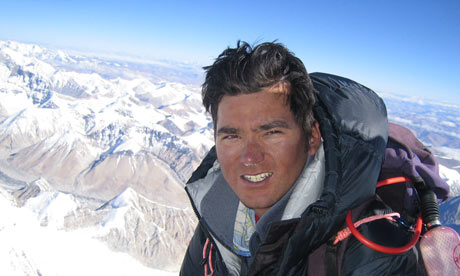Himalayan sherpas bugged by the sight of house flies at 5,000m

Dawa Steven Sherpa is one of WWF climate witness in Nepal. Photograph: WWF
Earlier this year Dawa Steven Sherpa was resting at Everest base camp when he and his companions heard something buzzing. "What the heck is that?" asked the young Nepali climber. They searched and found a big black house fly, something unimaginable just a few years ago when no insect could have survived at 5,360 meters. "It's happened twice this year - the Himalayas are warming up and changing fast," says Dawa, who only took up climbing seriously in 2006, but in a few years has climbed Everest twice as well as two 8,000m peaks in Tibet.
"What I do is climb. It's a family business. And what we see is the Himalayan glaciers melting. It's not a seasonal thing any more. It's rapid. It's so apparent.
"Look at the walls and slopes of the Khumbu glacier [which flows 1.5 miles down from an icefall on the southern flanks of Everest]. "You can see a clear line where the black rock becomes white. That's where it's been exposed to the sun. That means metres of thick ice have melted in just a few decades," he says.
Dawa was born in Khumjung, a village just 12 miles from Everest which lies at 3,500m above sea level. His father used to climb with British mountaineer Chris Bonnington, and his grandfather, a yak traderwho toured the world with Everest's first summiteer, Sir Edmund Hillary.
All three generations of Dawa's family testify to major climate change taking place today. "Grandfather used to take yaks to a place called Gokio which was on the other side of the Ngozumba glacier, Nepal's longest. He could walk them over the ice but now it's just not there – it's a stony wasteland. The whole thing has melted," he says.
He lists some of the physical changes he has seen and their effects on local communities. "The permanent ice above our village now melts at about 5,500m, but it used to be 3,750 metres. Our village is seeing prolonged droughts. They used to last a few months. Now we can go seven months without rain. We have less water now and erratic weather patterns.
"The young girls must now walk two hours to fetch water. Tourism, too, is being hit because villages like Khumjung, which used to have a lot of water for trekkers now don't have it. The villagers lose their business. "All the Himalayan glaciers are melting, an average of 10-20m a year," he says.
One of the most obvious changes, he adds, is the growth of what are known as glacial lake outburst floods (glofs). "A glof happens when a glacial lake is created by a melting glacier and it then bursts. Imja lake is the most dramatic example of a potential one. It is growing 74m a year. When it bursts its banks, we will have a mountain tsunami. Billions of gallons of water will be released and it could wipe out about 70% of the trekking trail to Everest base camp. Not only will that destroy our homes and potentially kill people, but it will wipe out the jewel in the crown of Nepal's tourism industry," he says. Last year villagers got an early warning of what they might expect. A very small lake at the edge of the Khumbu glacier burst and it washed away four bridges on a track up to Everest base camp.
Dawa, now 25, has a Belgian mother, a degree in business management from Heriot-Watt university in Scotland and he speaks five languages. He is a WWF ambassador on climate change and runs major expeditions into the Himalayas, climbing with his friend Apa Sherpa, who has climbed Everest 19 times - the world record.
Everest itself is changing, he says. "Apa says there was running water on the surface of the South col [a saddle at 7,920m between Everest and Lhotse mountain] this year," says Dawa. "Also the summit is getting smaller. You used to be able to get 50 people on the ridge to it. Now there's room for 18 people at most. The cornice is breaking off. A big crevasse is opening. It never used to exist. It seems nothing is safe anymore."
Nothing compares with the beauty of standing on the summit of Everest and seeing far over the mountains, he says. But finding a fly buzzing thousands of metres up is horrifying.
The text and photo(s) in this article is taken from The Guardian. It is not allowed to be copied or interpreted without the permission of the original source, in part or as a whole, in any context or for any purpose. Please come up with your own content. We are using it for formatting purpose only. None of its content to be considered true and reliable fact or knowledge. Consider it a placeholder for text and pictures only.
The break-up of the Petermann Glacier 26-09-2011
Himalayan sherpas bugged by the sight of house flies at 5,000m 26-09-2011
Climate change may leave Mount Everest ascent ice-free, say climbers 26-09-2011
Kenya's road to recovery: Can the parks be saved? 26-09-2011
Fallout on the Fu 26-09-2011
The Gathering Storm 26-09-2011
Those Wily Russians! 26-09-2011
Everest Gets Torched 26-09-2011
Remembering Italian Mountaineer Walter Bonatti, 1930-2011 25-09-2011
Wingsuit Daredevil Jeb Corliss Will Fly Through a Mountain Cave in China 25-09-2011





